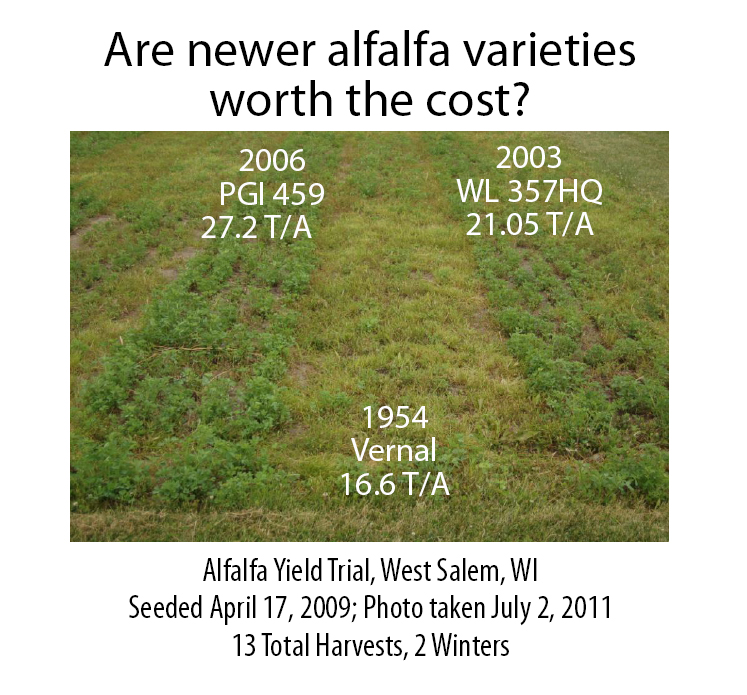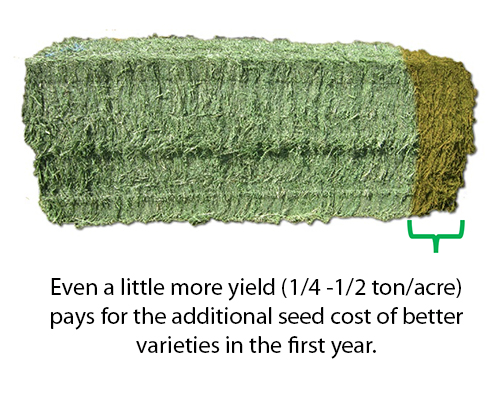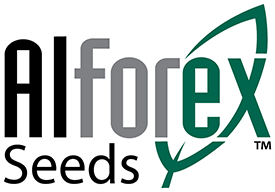Are New Alfalfa Varieties Worth the Added Cost?
The Value of New Alfalfa Genetics
Don Miller, Alforex Seeds Director of Product Development
When it comes to seed cost there is always the debate on what variety to buy and how much is it going to cost. There can be a wide range in the price for alfalfa seed and farmers often ask the question, “Are New Alfalfa Varieties Worth The Added Cost?”. There is always the temptation to select the cheapest variety and save some money on the planting costs. However planting an outdated cheaper variety may save some money initially, but in the end, the potential revenue loss due to underperformance can be significant, especially in the case of a perennial crop like alfalfa.
The selection of an underperforming corn or soybean variety affects profits for a single year and a poor variety choice can be corrected the next year. However, the selection of an inferior alfalfa variety can have a negative multiple year negative effect. The decision of what variety to buy should be tempered not only by the initial cost, but also by the profit potential that variety provides over the next 3-5 years. You can always buy a cheap variety, and there are plenty of them out there. However you should consider that even with the best management and fertility program, it’s very difficult to achieve top yields or stand performance from a “low cost/low profit” alfalfa variety.
If you do the calculations, seed is the least expensive input an alfalfa farmer has in growing the crop. Alfalfa seed cost is relatively low compared to other crops, especially since it can be prorated across the life of the stand which is normally 3-5 years. Below are some calculations that illustrate that comparison along with the per acre cost of buying a better alfalfa variety:
Corn 1: ————————————————————————————— $115 /ac/yr.
Soybeans1:———————————————————————————- $69 /ac/yr.
Wheat1: ————————————————————————————— $44 /ac/yr.
Alfalfa
Cheap Seed:
$3 / lb. x 18 lbs./ac =$54 prorated over 4 years = $13.50 /ac/yr.
$4 / lb. x 18 lbs./ac =$72 prorated over 4 years = $18.00 /ac/yr.
$5 / lb. x 18 lbs./ac =$90 prorated over 4 years = $22.50 /ac/yr.
Better Variety:
$6 / lb. x 18 lbs./ac =$108 prorated over 4 years = $27.00/ac/yr.
Spending $1-2 more per pound for better alfalfa genetics, is very economical compared to the annual seed costs of other crops.
12018 Purdue Crop Cost & Return Guide: Purdue Extension ID-166-W
How Does Cheap Seed Become Expensive?
- Not Adapted; Poor Winter Survival (Replanting Costs and Lost Yield)
- Poor Insect Resistance (Spray Costs For Insects >$20/Ac)
- Lack of Resistance to New Pests or Diseases (APH-2, new aphid biotypes etc.)
- Lack of Disease Resistance (Lack of Persistence ; 1-2 years less stand life))
- Poor Quality Seed (Herbicide Costs to Control Weeds)
- Low Yield (Less Tonnage to Sell or Feed)
- Poor Forage Quality (Less Money for Lower RFV/RFQ Analysis)
Alfalfa Genetic Improvements
In the last 60 years there has been significant genetic improvements made in alfalfa for a wide range of traits, as can be seen by the number of variety releases listed below. These improvements have resulted in improvements for yield and/or forage quality over a wide range of environments and stress factors.

Cultivars Approved by the North America Alfalfa Variety Review Board
- 1960’S 49 New Varieties
- 1970’S 99 New Varieties
- 1980’S 204 New Varieties
- 1990’S 672 New Varieties
- 2000’s 776 New Varieties
- 2010-19 703 New varieties
- TOTAL 2503 varieties
Advantages of an Improved Variety: More Profit Potential!!
- More Yield Potential
- Better Forage Quality (improved fiber digestibility and leaf to stem ratio)
- Better Stand Persistence (1-2 more productive years)
- Better Resistance to Pests ( minimizes insect and disease related losses)
- Resistance to New Pests
- Better Performance Under Stress Conditions
- Better Harvest Management Flexibility
Seed Cost Of A Good Variety (Why It’s Worth It)
The additional cost the farmer pays for a good variety almost always pays for itself with increased yield and/or improvements in forage quality. If you look at Midwestern forage trials, the range in yield differences within a trial are quite significant. The first year yield spread from top to bottom in six university trials (WI,OH,MI,NY,MN, and PA) averaged 1.6 tons, and after 3yrs the yield difference was 4.3 tons. Even if the added cost of a new improved variety is $1-2 more per pound, a yield advantage of even a ¼ ton/ac/yr. at $150/ton, more than pays for the added seed cost in just the first year, and has the potential to add $114 more profit per acre over the life of the stand.
University Of Minn., Alfalfa Yield Trials, Rosemount, MN:2017-2019
Variety 3 Year Total
AFX 469 15.0 tons/acre
Vernal 12.5 tons/Acre
Dollar Value of Better Variety
2.5 tons @ $150/ton= $375/acre – seed cost of better variety ($20-40/ac)=$335/ac.
Potential Profit Advantage of a Better Variety = $335/Acre

Value of Improved Forage
Alfalfa hay in the U.S. is bought and sold based on the USDA quality standards of 4 classes; Supreme, Premium, Good, and Fair. Higher quality relates to better animal performance and is therefore worth more money. For this reason many of the new alfalfa varieties have been bred for improvements in forage quality (improved fiber digestibility and leaf content). If a high quality alfalfa can test one grade higher in quality, that improvement is generally is worth at least $20 or more a ton. The potential profit for higher quality is obvious going from Premium to Supreme, but in reality any movement to a higher grade still results in more profit.
Summary
The selection of an Alfalfa variety should not be determined solely by how inexpensive the seed is, but whether it provides the most profit potential for your farm over the life of the stand. A better forage quality test or a ¼ ton increase in yield on just one cut more than pays for the cost of a better variety, usually in the first year. No matter how well you fertilize, or manage a “low cost/low profit” variety, it’s very hard to overcome underperforming genetics that just doesn’t have the traits needed to obtain your yield and forage quality goals.
Additional Resources


Pingback:Alfalfa Livestream How to Pick Alfalfa Varieties – Alforex Seeds